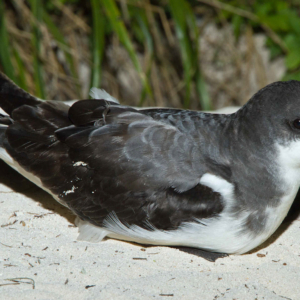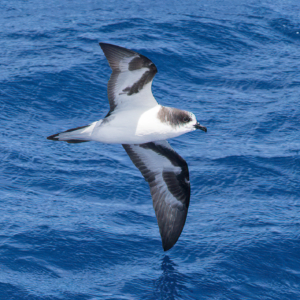Bonin Petrel
Click on an image to enlarge it
Status: Endemic, Least Concern
Hawaiian Name: nunulu
Scientific Name: Pterodroma hypoleuca
Population: There are approximately 270,000 – 395,00 breeding pairs that are found mostly in the Northwestern Hawaiian Islands. There are an estimated 995,000 worldwide.
Feeding: Bonin Petrel’s primarily feed on lanternfish, hatchet fish, and squid.
Breeding: Pairs mate for life. The pairs will chase and call to each other over the colony prior to laying.
Life Cycle: Bonin Petrel’s lay one egg a season. The egg is usually laid in January with fledging occurring in June. Both parents participate in all aspects of raising their young. The nest is located within a borrow which is excavated out of the sandy soil. They are only able to lay one egg a season.
Conservation Actions: With introduction of mammalian predators, such as rats, cats, mongooses, and rabbits (primarily rabbits and rats on Midway Atoll) the Bonin Petrel colonies along with other seabird colonies have been declining. Controlling these introduced predators with live trapping, snap traps, and other methods to eradicate introduced predators has shown to exponentially increase native seabird populations in declining areas.
Nonnative plants that have also been introduced such as Golden crown-beard, and Sandbur can degrade the soil in the nesting colonies
With introduction of mammalian predators, such as rats, cats, mongooses, and rabbits (primarily rabbits and rats on Midway Atoll) the Bonin Petrel colonies along with other seabird colonies have been declining. Controlling these introduced predators with live trapping, snap traps, and other methods to eradicate introduced predators has shown to exponentially increase native seabird populations in declining areas.
Nonnative plants that have also been introduced such as Golden crown-beard, and Sandbur can degrade the soil in the nesting colonies
Bonin Petrel and PRC: Over the years PRC has played an important role in translocating Bonin Petrels leading to great success at JCNWR.
Sources: https://dlnr.hawaii.gov/wildlife/birds/bonin-petrel/
https://dlnr.hawaii.gov/wildlife/files/2019/03/SWAP-2015-Bonin-petrel-Final.pdf



